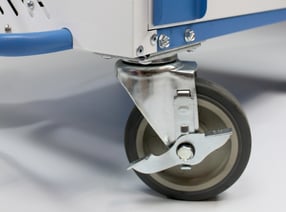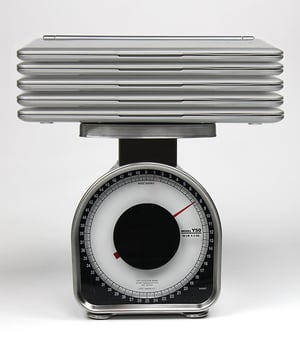When it comes to charging and storage solutions for mobile devices, there is a wide selection of products available to educators that offer a range of features and functionality. One such solution is the charging "cabinet" or "wall unit", which is typically advertised to accomplish exactly what it sounds like it would—to store and charge devices in a unit that can be affixed to a wall or, often, to a countertop. If you need to preserve space in a classroom and do not need to share the devices between rooms, then a charging cabinet sounds as though it could solve a lot of your problems, right?
Unfortunately, this is not always the case, especially in many education scenarios. Keep reading for some food for thought on whether a wall unit or cabinet is really what you need. I will cover some of the top reasons people seek out these units and discuss some of the downsides to them.
 Who needs transportation?!
Who needs transportation?!
Unlike technology carts, charging cabinets are mounted to the wall or a counter top, making them a static piece of furniture in the classroom. If you know that you will not need to share the devices with another class or bring them anywhere, then you may find this to be a non-issue.
There are a few things to consider here, though. What happens with a charging cabinet when teachers inevitably wish to rearrange their classroom furniture? It is crucial that cabinets are installed correctly or they can become a hazard and these things are fairly heavy, even when they are empty. This may require a qualified custodian to come in to move and re-mount the unit each time it is decidedly in the way. Overall, carts are just easier to move around—they do have wheels after all! If you think that you may have to move or just take down the unit at some point for any reason, a cart might just be a more manageable choice, especially if you need them for every room.
 Do cabinets really equate to more space?
Do cabinets really equate to more space?
The ability to mount the cabinet to the wall sounds awesome, right? In some cases, this can be a functional solution when there is limited space to work with.
On the other hand, charging cabinets must be mounted at a height where the devices will be easily accessible to teachers and/or students because we all know that balancing on a chair to access the devices would be an accident waiting to happen. Some of these wall units are bulky and stand off quite a bit from the wall, so the space below the unit may or may not even be usable.
Some companies even instruct users to mount their cabinet unit to a desktop rather than to a wall because of the liability of making sure the unit is anchored properly. Having to secure an immobile unit to a table consequently reduces counter space for teachers, which is not necessarily a space-saver. Moreover, classroom furniture is not typically designed to support large quantities of weight. This means that the weight of the cabinet should be considered, regardless of whether the unit is attached to a wall or a countertop. If it is on the wall, it should be made clear that users should not put any unsupported items inside or on top of the cabinet that would add to the weight.
 Are cabinets less expensive?
Are cabinets less expensive?
Charging cabinets may appear to be a less expensive alternative to purchasing carts, but, ultimately, charging cabinets are not a cheap solution and cost upwards of 600 dollars. When you consider that cabinets generally have a lower weight limit than carts do, which severely restricts the number of devices that can be stored inside, the cost versus the capacity may actually be the same. It is also important to consider that most available charging cabinets range in capacity from ten to twenty devices, which is not enough to accommodate the average class size if you plan on every student having access to a device.
So, when should I buy a charging cabinet?
Wall units or cabinets are best suited for situations where devices will be checked out one-by-one and returned to the same location, for lightweight devices like tablets or small Chromebooks, or when you only need to charge or secure a very low quantity of devices (8-10).
Here's why: There are options for low-cost charging carts that make sense for 11+ devices (of any kind), that are great to leave in place, but easy to transport when the time comes. These options can occupy less than two square feet of floor space and, for lower quantities, often have extra space inside that can be used for storage of peripherals or other items. In some cases, you can even stow them below a countertop. They are also typically more versatile than cabinets, so you may find that they even suit your needs for a longer period of time.
Think you may be interested in a mobile cart? Check out the Ultra-Light mobile cart that will grow with you! This sturdy, cost-efficient, lightweight mobile cart easily transports the weight of your devices and puts you in control by providing you with the features you need now with options to upgrade later.

